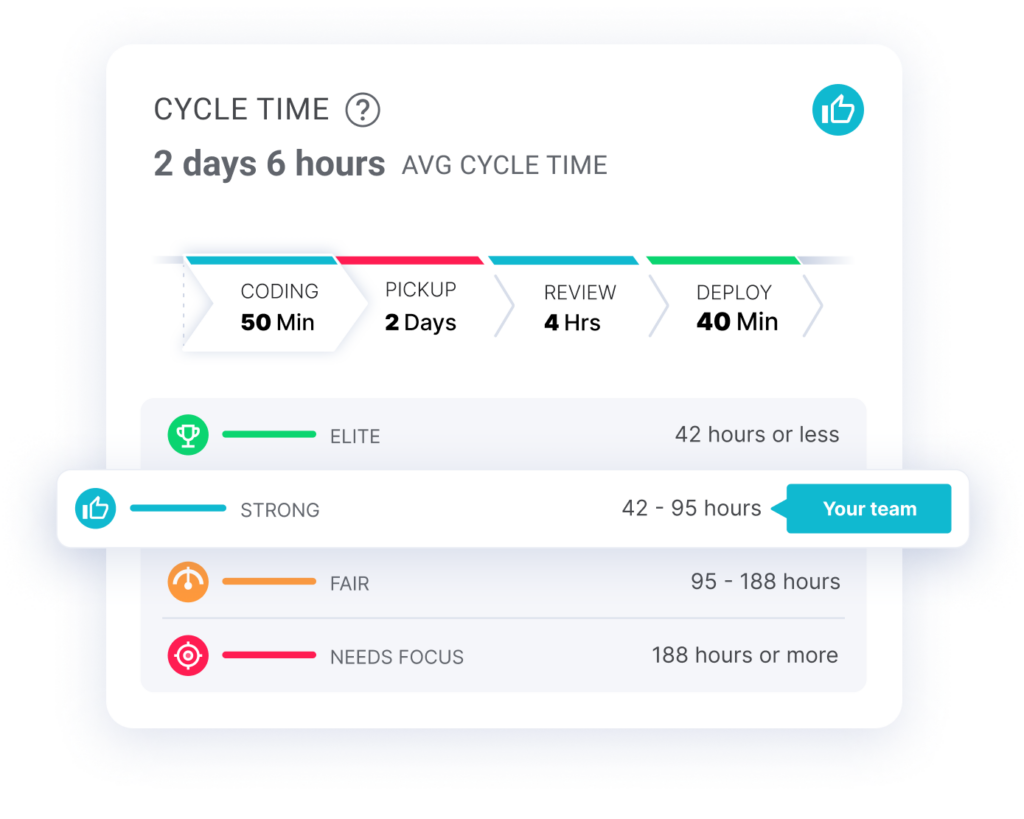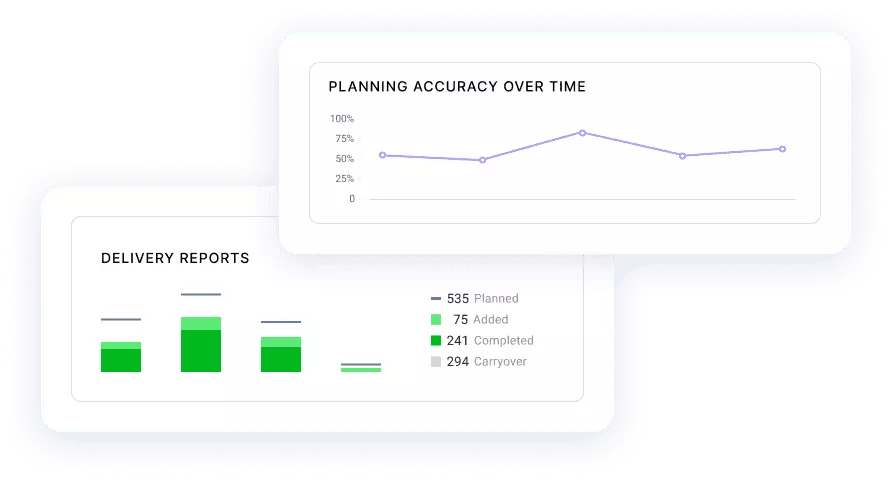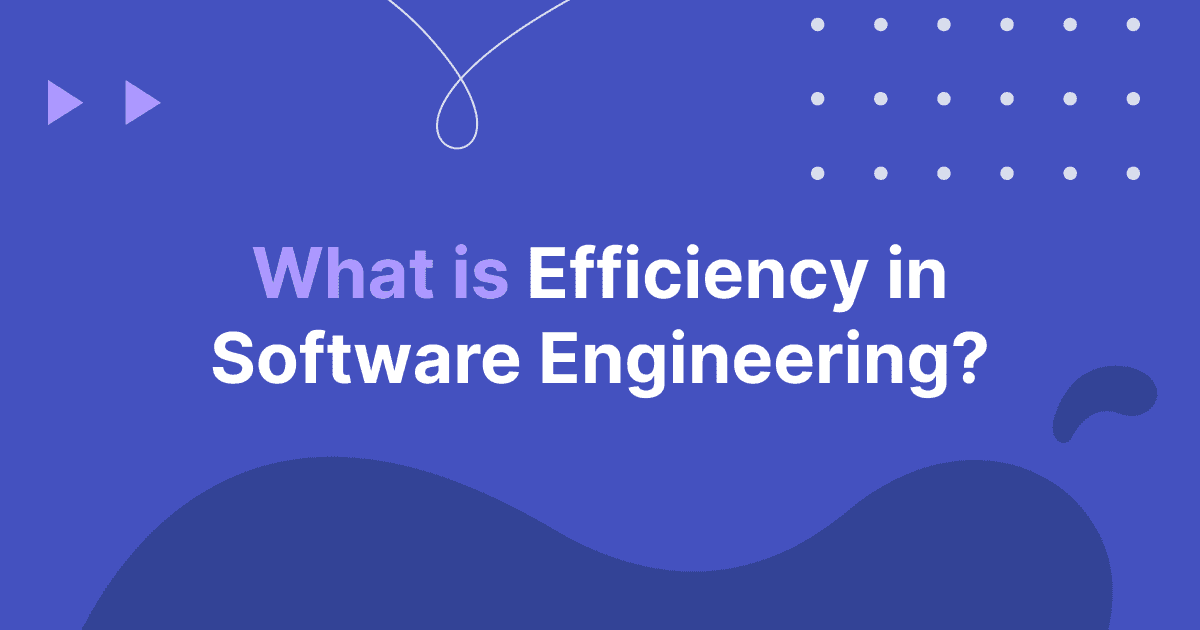The software industry is becoming increasingly competitive, so successful software development needs the utmost focus and attention. Budget cuts mean your teams are either in a hiring freeze or being reduced, and the execs are pressuring you to show that your teams are performant.
The bottom line is that your engineering org needs to be hyper-efficient. But what is efficiency in software engineering, anyway? Is it just about eliminating bottlenecks and being productive? You’ve got great teams under you, but how can you show other execs that they’re performing well? Being efficient is the key, and we’ll show you how.
Table of Contents
- Defining Efficiency in Software Engineering
- Engineering Efficiency vs. Productivity
- 4 Metrics to Measure Efficiency in Software Engineering
- Increasing Engineering Efficiency with Software Development Analytics
Defining Efficiency in Software Engineering
Efficiency in software engineering means more than just making sure the job gets done. It means the effort put into the work was the best bang for your buck.
To put it another way, efficiency typically means measuring the output of the work compared to the expected outcome. Did the finished product take more resources (staffing, time, budget, etc.) than expected?
Here are some examples of things that can make a project need more time and resources than planned:
- High cycle times
- Large number of bugs
- Lengthy PR processes
- High code churn
So, when discussing your software development teams’ efficiency, you have to look at the entire process. This way, you can see how much effort went into getting your desired output.
Improving your process results in a shorter product life cycle, a faster time to market, and a high-quality product. But you can’t just focus entirely on efficiency. Productivity is equally important — you can’t have one without the other.
Efficiency in software engineering means more than just making sure the job gets done. It means the effort put into the work was the best bang for your buck.
Productivity vs. Engineering Efficiency
Despite the common misconception that they are, development productivity and efficiency are not the same things. The distinction is a matter of quantity vs. quality.
In general, productivity is the quantity of work accomplished in a given amount of time. Productivity is easy to measure, which is why many people pay attention to it. Productivity is a great thing to measure, but it can make you lose sight of the bigger picture if you’re only focused on it.
Your teams can increase production, but that doesn’t mean they produced quality code. If you’re moving too fast, you end up with code churn in the next sprint. In real life, this happens with orgs that value developer velocity too much. In an effort to maintain velocity, teams will start cutting corners, and that’ll make code quality suffer greatly. So don’t fall into this trap — velocity isn’t a good measure of productivity.
In comparison, software development efficiency seeks to maximize output in a given time frame. This involves doing things properly so you aren’t sacrificing quality to crank out more. Engineering orgs have to focus on both productivity and efficiency as they go hand-in-hand. You can have your cake and eat it too, we promise.
Check out this snippet from the dev Interrupted podcast where Ben Matthews, Director of Engineering at Stack Overflow, explains his point of view about developer velocity.
4 Metrics to Measure Efficiency in Software Engineering
Not all teams work at the same level of efficiency. So you need to determine which KPIs will guarantee max efficiency in your org.
Some engineering organizations use lines of code, like some new CEOs at large social media companies that don’t understand how software engineering works *cough, cough*.
However, metrics like lines of code only show you how much teams are producing. They don’t measure the value your development teams deliver to users. Let’s go over four factors you can use to measure efficiency in software development.
1. Cycle Time
Cycle time is the time it takes from when work is started (i.e., first commit) to when it’s delivered (i.e. released to production).
By measuring your teams’ cycle time against industry standards, you can evaluate their performance. “But you just said speed doesn’t matter!” We know what we said. Cycle times are important because they highlight hiccups in the development process — if they’re long, something’s not right somewhere.
Using LinearB, you can quickly assess the duration of each stage in the software development lifecycle and all your teams’ cycle time. We also measure four phases of cycle time — coding time, pickup time, review time, and deploy time — so you can get a more detailed analysis.
Our Engineering Metrics Benchmarks highlight what’s working and what needs improvement. And when you add in Team Goals and our developer bot, WorkerB, you get a platform that lets you quantify your team’s productivity and how efficient your teams are with their time.

2. Planning Accuracy
Planning accuracy is the number of completed story points out of the planned story points. It helps development teams determine if they can meet delivery deadlines for a project. With it, you have an overview of the project’s trends. And this allows teams to effectively evaluate their capabilities, establish reasonable targets, and predict whether they can follow through on their commitments. When you have better planning accuracy, you’ll be able to deliver on your promises and show the execs your engineering org is as efficient as can be.
But from our research at LinearB Labs, we know that in 2021, less than half of the 1,900 Scrum teams analyzed had sprint plans that were accurate on average. This means teams typically missed the target lead time. LinearB correlates data across your platform and quickly identifies potential bottlenecks, like tasks carried over from the previous cycle or unplanned work.

3. Resource Allocation
Resource allocation measures how much time and effort your teams put into each project. This metric will give you and your teams something concrete to talk about when discussing their capacity. It’s easy to go over budget, miss deadlines from missing team members, or overestimate how much your teams can get done. And proper resource allocation is the key to keeping these things in mind, in and out of the planning process.
You can’t predict a sprint to go perfectly every time. Devs can get sick, you risk facing some employee turnover, or teams get sidetracked working on other things. It happens; we get it. But if you pay attention to your resource allocation, you’ll have a way to see whether engineers are working on the company’s most important goals.
Resource allocation allows fruitful discussions on how to meet competing demands on a few resources. With this in mind, you can ask questions like “Are we investing our time and effort into projects that are the most important to the business?” or “Do we have the power to start a new project right now, or should we focus on what’s already in the works?”. When you answer those questions, you’ll know whether your teams are delivering quality over quantity.
4. Deployment Frequency
Deployment frequency is the rate at which a development team delivers new code into production. When you make the deployment processes as easy as possible, you can shorten cycle time, and significantly reduce the time that production-ready code spends waiting. To achieve that, you can make smaller, more frequent deployments, automate your CI/CD pipeline, or even just set goals to have a certain number of deployments in a specific time frame.
It’s one of the first engineering metrics most teams will adopt, and it’s the easiest to track. You simply have to count how many code changes you make over a period of time. LinearB bakes this metric into the platform with tools like our Deployment API that shows you every phase of your deployment process. And when you add in Team Goals, your dev teams will see that their efforts are going to things that truly matter. And when they hit these goals one after the other, you’ll know you’ve achieved peak efficiency in software engineering.

Increase Your Efficiency in Software Engineering with Software Development Analytics
You can’t draw blood from a stone, and pushing your teams to do more can be challenging, especially when you don’t know what’s holding them back. But when you focus on measuring software engineering efficiency, you’ll be able to see (and remove) the bottlenecks your devs are facing. And this way, you’ll be able to do more with the same teams, ensuring your efforts are producing high-quality products your whole company can be proud of.
What gets measured gets done — so you can’t achieve your goals without measuring things. And LinearB can help. Our developer workflow automation tools help devs with the small stuff, so they can increase their efficiency. And our well-chosen analytics will help you make data-driven decisions and show execs your teams mean business.




